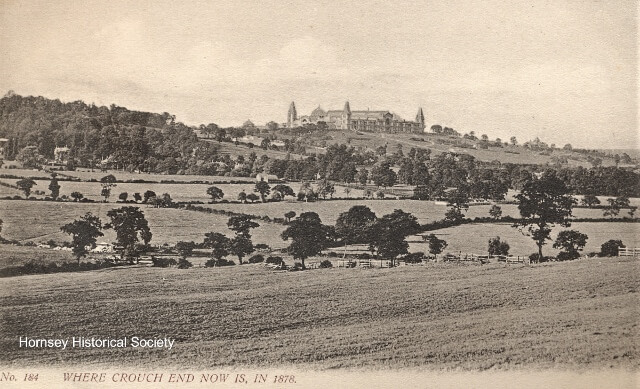A 1972 series of Hornsey Journal articles by Ian Murray, first Chairman of Hornsey Historical Society and aHaringey Council Archivist. The HHS gratefully acknowledges the kind permission of Archant/Ham and High for this reproduction.

Crouch End is derived from an old English word meaning ‘cross’ and ‘end’ is obviously what it says, an end, boundary or limit. So, the name means the cross boundary. The cross refers either to cross roads as four roads have converged here for centuries, or to an actual cross for which there is some evidence.
JE Lloyd in his History of Highgate (1888), suggests that there was a wayside cross here where pilgrims would rest on their way to the shrine of Our Lady of Muswell. This belongs to the realm of speculation, not to say imagination, for the only mention of such a cross comes from the isolated court roll for November 1375 when some tenants of the Manor of Hornsey were fined, ‘because they did not come to the cross, to wit the place accustomed, to make satisfaction to the lord for the pannage of pigs on St Martin’s Day’.
This central position at Crouch End, marked by a cross, is the most likely place for the tenants of the manor to meet the bishop’s officers in order to pay their rents and dues. It also marked the boundary, which is inferred in the name, between the manor of Hornsey and the sub-manor of Topsfield.
Crouch End, or Crowche Ende, is only mentioned in the records by name as late as 1421, though the name is undoubtedly much older. An allusion to the place in the form of a personal name occurs in a document of 1353. Thomas Maynard granted some land at that date to Adam in the Felde, a carpenter, ‘near the gate of Stephen atte Cruche of Haryngeye’. At that time it was common to name people after where they lived, for example, ‘Stephen who lived at the Cross of Haryngeye’ or Crouch End.
Rose Garland
Then Crouch End was merely a hamlet (and a hamlet it remained until quite recently) within the sub-manor of Topsfield, part of the Bishop of London’s manor of Hornsey. The first lord of this manor known to us is Stephen Maynard from a deed of 1374 whereby he commuted the rent of 41d., payable by one of his tenants, Geoffrey atte Cruche, ‘of the town of Haryngeye in the manor of Toppesfeldes’, for a garland of red roses to be rendered annually on Midsummer Day. Stephen Maynard is remembered by The Maynard Arms in Park Road, which itself used to be called Maynard Street.
All that survives to remind us of the manor in Crouch End is Topsfield Parade, although it can be traced back to before 1290 when it was held of the bishop on payment of 21¾ annually and attendance at his courts. The lord had the right, however, to hold his own courts for the purpose of granting land to tenants and exacting rents and services. It probably acquired its name from Richard de Toppesfield, a London citizen of Essex descent who purchased land in these parts in 1342.
Demolition
The manor covered about 50 acres on the east side of Crouch End and Crouch End Hill, extending along the old parish boundary to Ferme Park Road. This was the eastern boundary of both Tops-field sub-manor and Farnefields sub-manor, and so down the hill to Tottenham Lane. The old Manor House was Tops field Hall (the manor was in fact sometimes called the Manor of Topsfield Hall) which stood on the corner between Middle Lane and Tottenham Lane. It is mentioned several times in history from the earliest reference in 1524 which is to a house on the site, ‘a messuage called Broadgattes’, until its demolition in 1894 after the death in 1892 of Sarah Elder, widow of Henry Weston Elder, the last lord of Topsfield, who had died in 1882.
In debt
The descent of the manor can be traced without a break from Stephen Maynard in 1374 until 1524, when Nicholas Spencer sold it to his sister Agnes Tykyll. He was in great debt ‘and fallen to extreme necessity and poverty, nor being able to pay his debts but like to be laid in prison … was enforced for that cause to make sale of the premises to the intent to pay therewith his creditors whereby he might keep his body out of prison’. In the succeeding centuries, information about Crouch End becomes more plentiful, particularly about the large houses which existed until the district was built up in the 1880s and ‘90s.
Website editor’s note
In two weeks time Topsfield Hall will be the subject of the next in the series of‘Lost Houses’ with images of both the house and grounds.
Image credits
HHS